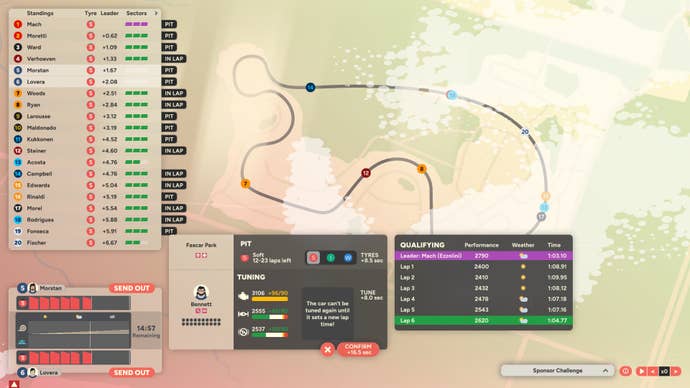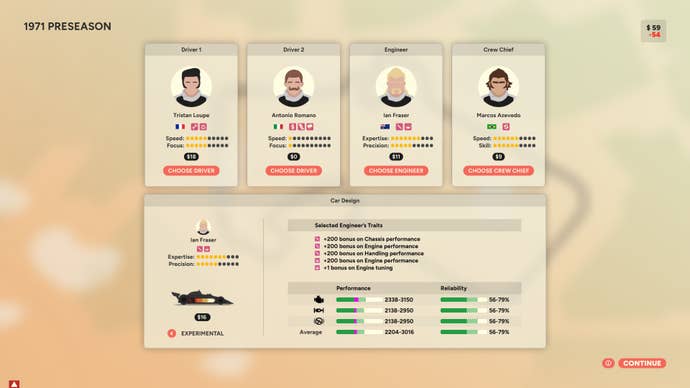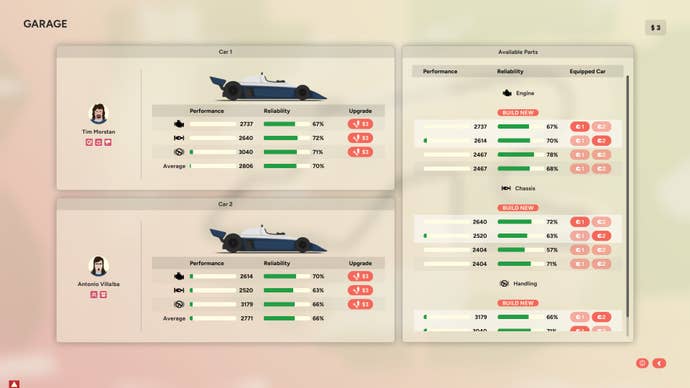Golden Lap review: A love letter to racing’s past with near-immaculate vibes
Managing your team through an F1 golden era dripping with glamour, danger, and plain old oil is an almost meditative experience at times.
I can taste the champagne. Then, suddenly, I can’t.
Both not quite Ferraris are out of the not quite Monaco Grand Prix, taking with them the dominant force that’s monopolised the top step on the podium through three races in 1970. For a brief moment, my not quite Williams team is on course to take its first win under my management with a one-two in the principality.
It feels guaranteed.
Then, one of our cars slams the barriers, and everything gets a lot more precarious. It’s all down to my remaining driver, Briton Tim Morstan - with his crap goatee and very 70s hairdo - to bring it home. All he has to do is finish, without backing off enough to get mugged by one of the few remaining threats behind. For something like thirty laps, I watch on tenterhooks as his on-screen dot perilously threads the needle between barriers that I can’t see, but know are there.
Tim makes it home, and takes the win. Next season, he’ll take all ten victories on offer and romp to his first championship. The season after that, he’ll fail to defend his crown despite drawing on points with the new team mate I’ve hired for him - Antonio Villalba, a fella so jealous in nature he throws such a wobbler if he’s in a worse car than Tim that he goes from the best driver in the world to below average.
As you play through the career mode of Golden Lap, the racing management sim from Art of Rally and Absolute Drift studio Funselektor Labs, in collaboration with Strelka Games, you’ll write your own history just like this. This mode is very much the big draw of the game, and having had a chance to dig in a lot deeper than I could when I played Golden Lap’s Steam demo earlier this year, I’m glad to report that a lot of the stuff I loved then is just as lovely after significantly more hours.
The way the audio and visuals blend together to create something that’s very pleasant, but can be ripped aside at an instant to convey the seriousness that one of the cars buzzing around your track map hitting the barrier entails. The simple gameplay loop of setting up a team by hiring four people whose personality quirks and stats you like, then deciding how much of a risk you want to take performance-wise on a baseline car. The way you’ve always got to be thinking on your feet as to which tyres you should be on, how much fuel you can burn, or how to manage the amount of stress you’ll put your driver under if you ask them to push for an overtake, or keep a pursuer behind.

That’s all still great, and it blends together with some other pro’s that I’ve only been able to experience in the full version of the game. The slate of parody tracks are all wonderful, from Francis Hollow to Sake Speedway, paying homage to real-world counterparts through traits and the corner names you’ll discover if you hover over most bends. The latter really helps infuse the game with the same subtle sense of humour as Funselektor’s prior releases, and the whole slate offers enough variety that things don’t get stale quickly.
The variety in drivers and team personnel is just as well done, with a huge range of different combos on offer to suit whatever build you might be going for. At the top end, you’ve got folks who’re just boringly good at their jobs, at the bottom you’ve got a selection of vaguely or genuinely crap options that cost pennies, and in the middle, you’ll find the real F1 people. Potential world-beaters in the right situation, but otherwise flawed in ways that can range from being too methodical to overtake quickly, being prone to lobbing it in the wall on a regular basis, just being a straight-up jerk that engineers can’t stand. They’re your Heinz-Harald Frentzens, your Romain Grosjeans, or your Jean Alesis.
That said, the main hang-up I did encounter had to do with a weird quirk of the game’s driver market. As I mentioned when I previewed it, Golden Lap works drivers able to be killed or injured in crashes - as was a depressing reality of the time - into its gameplay. Generally, the way it’s handled is brilliantly poignant, and the cadence at which such tragedies happen feels natural, however, when dead or injured drivers are replaced, the game seems to draw from a pool kept separate to the main driver market. Some of the drivers in this pool - I kept encountering Lucas Verhoeven and Ethan Ward - are just as good as some of the top drivers on the market, only they’re often getting plugged into cars further down the grid and vastly outperforming where those cars should run and finish.

This has a pretty significant effect on how not just a season, but an entire career can play out, with getting on one of these drivers often leading to a team bagging significantly better finishes with that car than it otherwise would have, increasing the budget it earns via its constructors standing at the end of the year. This wouldn't be as much of an issue if these drivers always parlayed their dragging of an also-ran to the very front or upper mid-pack into a full-time drive at a better team for the subsequent season, but thus far I’ve only seen one of them ever crop up on the general market to be hired my myself, before landing on a fittingly good AI team when I passed. Across two different career mode saves, it was pretty frustrating and immersion-breaking, so will definitely need sorting given what the game’s going for.
These drivers also didn’t show up in the pool I was given to hire from on the one occasion when one of my drivers tragically perished. The fact I could only afford a pay driver anyway, as I was early in the second season of a playthrough with Night - the small team that starts off at the very back of the grid - and had spent all my savings in the off-season on totally revamping the team into a competitive one through hirings and car development, just added insult to injury.
To be honest, though, that accident - since it took away the one genuinely good driver I’d been able to hire and who’d then been able to storm to the lead of the championship over the first two races - was rather the exception to the difficulty rule. While it often took the switch between seasons to take a jump towards the very front of the grid, in the career save I spent the most time with, once I was there, I didn’t have too much trouble staying on top.

While it might mess with the wonderfully relaxing minimalism that defines Golden Lap, maybe getting slightly more complex in terms of how you have to manage the relationship between different team members - especially if you’ve got two drivers fighting for the title - might make a worthwhile addition. After all, F1 in any era is as much defined by the behind-the scenes and on-track handbags between its racers and the folks who’re helping them do the racing.
Beyond that, while the Career Mode is very much beefy and well-executed enough to carry the game as its sole mode, aside from a quick race mode that lets you pick a preset team and compete in a single event, I do think adding in something like a custom championship mode in the future would be a shrewd move. Even if it just came in the form of letting you play god over being a competitor a bit more in a career save - picking the tracks on the calendar for each year and maybe getting some other tools to help you engineer your own scenarios.
Overall, the release version of Golden Lap, even with those couple of areas where it could be better, is still very much the game I enjoyed in a short burst earlier in the year. It knows exactly what it wants to deliver, and does so in the wonderfully characterful manner that’s come to define Funselektor’s games and help them stand out from the racing crowd. Without giving you an actual whiff of the petrol fumes, properly deafening you with engine roar from behind the wheel or offering you a mouthful of podium bubbly, it manages to capture the spirit of what it depicts, and with a few tweaks, its pull could be even more irresistible.
Golden Lap releases on September 26 for PC. This review was conducted on PC, with a code provided by the publisher.

